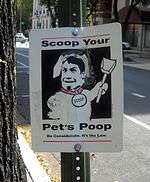Pooper-scooper
A pooper-scooper, or poop scoop, is a device used to pick up animal feces from public places and yards, particularly those of dogs. Pooper-scooper devices often have a bag or bag attachment. 'Poop bags' are alternatives to pooper scoopers, and are simply a bag, usually turned inside out, to carry the feces to a proper disposal area. Sometimes, the person performing the cleanup is also known as the pooper-scooper.
History
The invention is credited to Brooke Miller, of Anaheim, California. The design she holds a patent over is a metal bin with a rake-like edge attached to a wooden stick. It also includes a rake-like device to scoop the poop into the scooper and a hatch that can be attached to a garbage bag that fits onto the base. The generic term pooper-scooper was included in the dictionary from the early 1970s.
Legislation
A number of jurisdictions, including New York City, have laws requiring pet owners to clean up after their pets:
a) A person who owns, possesses or controls a dog, cat or other animal shall not permit the animal to commit a nuisance on a sidewalk of any public place, on a floor, wall, stairway or roof of any public or private premises used in common by the public, or on a fence, wall or stairway of a building abutting on a public .
Authorized employees of New York City Departments of Health (including Animal Care & Control), of Sanitation, or of Parks and Recreation can issue tickets.[1]
Such pieces of legislation are often nicknamed "Pooper-scooper Law", though in that case the dog's owner is expected to clean up the feces by hand.
Health concerns

Dog droppings are one of the leading sources of E. coli (fecal coliforms) bacterial pollution, Toxocara canis and Neospora caninum helminth parasite pollution. One gram of dog feces contains over 20,000,000 E. coli cells.[2] While an individual animal's deposit of feces will not measurably affect the environment, the cumulative effect of thousands of dogs and cats in a metropolitan area can create serious problems due to contamination of soil and water supplies. The runoff from neglected pet waste contaminates water, creating health hazards for people, fish, ducks, etc.[3]
The situation is particularly dire in Germany, where an estimated 1400 tonnes of feces are deposited daily on public property. A citizen commission (2005) overwhelmingly recommended a plan that would break even at about seven months. DNA samples would be required when pet licenses come up for renewal. Within a year, a database of some 12,500 registration-required canine residents would be available to sanitation workers with sample-test kits. Evidence would be submitted to a forensics laboratory where technicians could readily match the waste to its dog. The prospect of a prompt fine equivalent to $600 US (at 2005 exchange rate) would help assure preventive compliance, as well as cover costs.[4] In adult dogs, the infection by Toxocara canis is usually asymptomatic but can be fatal in puppies.[5][6] A number of various vertebrates, including humans, and some invertebrates can become infected by Toxocara canis. Humans are infected, like other paratenic hosts, by ingestion of embryonated T. canis eggs.[7] The disease caused by migrating T. canis larvae (toxocariasis) results in visceralis larva migrans and ocularis larva migrans. Clinically infected people have helminth infection and rarely blindness.[8]
See also
- Motocrotte - motorcycle-based solution for cleaning the streets of Paris
References
- Blackman, Diane (2003-07-14). "Dog Parks, Dog Runs and Off Leash Play". Dog Play. Retrieved 2006-07-21.
- "Parks Business Plan". King County Parks and Recreation Division. Department of Natural Resources and Parks. 2004-05-25. Retrieved 2006-07-21.
- Kargl, Reinhard (July 2005). "A Pooper Scooper Law with Bite. The Germans consider DNA testing to match poop to pooch". Science. Popular Science. Retrieved 2006-06-06.
- "The Scoop on Poop". ROMP. September 2000. Retrieved 2006-06-06.
ROMP (Responsible Owners of Mannerly Pets), metropolitan Twin Cities recreation-advocacy group; June 1996 in Roseville, MN, nonprofit incorporation April 2000 [About ROMP] - "Scoop the Poop Campaign". BurlingtonEcoInfo > Water > issues > Scoop the Poop. University of Vermont. n.d. Retrieved 2006-06-06.
- "Wildlife". NYC Health Code. Animal Care & Control of New York City. Retrieved 2006-06-06.
- Zand, Joel R., Esq. "New York City's Dog Poop Scoop Law". Legal issues and laws affecting dogs, companion animals, and their people. Joel R. Zand. Retrieved 2006-06-06.
New York attorney and dog lawyer;
Notes
- ↑ (1)
Zand, Joel R., Esq. "New York City's Dog Poop Scoop Law". Legal issues and laws affecting dogs, companion animals, and their people. Joel R. Zand. Retrieved 2006-06-06.
New York attorney and dog lawyer
(2) "Wildlife". NYC Health Code. Animal Care & Control of New York City. Retrieved 2006-06-06. - ↑ Coliform and E. coli are commonly used field indicators of fecal contamination by animals (including human)
- ↑ "Scoop the Poop Campaign". BurlingtonEcoInfo > Water > issues > Scoop the Poop. University of Vermont. n.d. Retrieved 2006-06-06.
- ↑ Kargl, Reinhard (July 2005). "A Pooper Scooper Law with Bite. The Germans consider DNA testing to match poop to pooch". Science. Popular Science. Retrieved 2006-06-06.
- ↑ Svobodová V, Svoboda M (1995). Klinická parazitologie psa a kočky. ČAVLMZ.
- ↑ Jurášek V, Dublinský P, et al. (1993). Veterinárna parazitológia. Príroda a.s. ISBN 80-07-00603-6.
- ↑ Gillespie SH (1988). "The epidemiology of Toxocara canis". Parasitol Today. 4 (6): 180–182. doi:10.1016/0169-4758(88)90156-1. PMID 15463080.
- ↑ Despommier D (2003). "Toxocariasis: clinical aspects, epidemiology, medical ecology, and molecular aspects". Clin Microbiol Rev. 16 (2): 265–272. doi:10.1128/CMR.16.2.265-272.2003. PMC 153144
 . PMID 12692098.
. PMID 12692098.